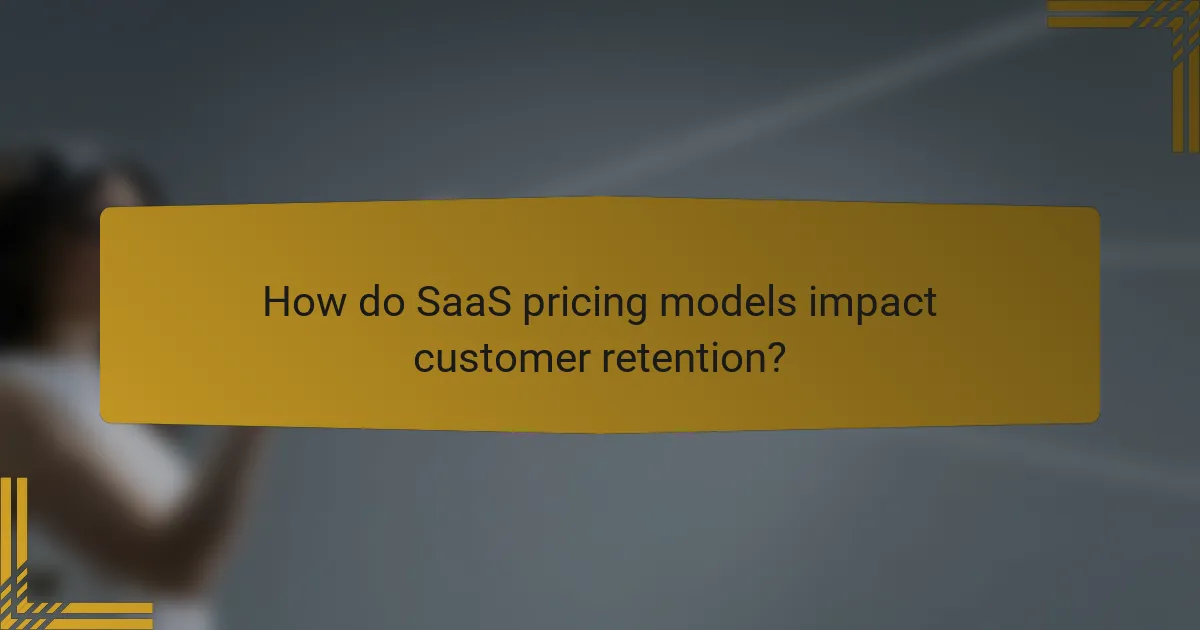SaaS pricing models play a crucial role in determining a company’s success by influencing customer acquisition and retention. Common models such as subscription-based, usage-based, and freemium each offer unique benefits that can align with specific business goals. Understanding these models and selecting the right one is essential for optimizing revenue and meeting customer needs.

What are the common SaaS pricing models in Canada?
In Canada, common SaaS pricing models include subscription-based, usage-based, freemium, tiered, and flat-rate pricing. Each model has its own advantages and considerations, making it essential for businesses to choose one that aligns with their customer needs and revenue goals.
Subscription-based pricing
Subscription-based pricing involves charging customers a recurring fee, typically monthly or annually, for access to the software. This model provides predictable revenue for companies and allows users to budget their expenses effectively.
Common examples include services like Adobe Creative Cloud and Microsoft 365, where users pay a set fee for continued access. Businesses should consider offering discounts for annual subscriptions to encourage long-term commitments.
Usage-based pricing
Usage-based pricing charges customers based on their actual usage of the service, which can be appealing for those with fluctuating needs. This model is often seen in cloud services like AWS, where costs are determined by the amount of resources consumed.
While this approach can lead to lower initial costs for users, it may result in unpredictable expenses. Companies should clearly communicate pricing structures to avoid confusion and ensure customers understand potential costs.
Freemium model
The freemium model offers a basic version of the software for free, while charging for premium features or services. This approach can attract a large user base quickly, as seen with platforms like Slack and Dropbox.
However, businesses must balance the features offered in the free version to entice users to upgrade without undermining the value of the paid tiers. Monitoring conversion rates from free to paid users is crucial for assessing the model’s effectiveness.
Tiered pricing
Tiered pricing provides multiple pricing levels, each with different features and benefits. This model allows customers to choose a plan that best fits their needs and budget, which can enhance customer satisfaction.
For example, a software company might offer basic, professional, and enterprise tiers, each with increasing features and support. It’s important to clearly define the differences between tiers to help customers make informed decisions.
Flat-rate pricing
Flat-rate pricing charges a single price for access to the software, regardless of usage. This model simplifies budgeting for customers and can be appealing for those who prefer straightforward pricing.
While it can attract users looking for simplicity, businesses may miss out on potential revenue from high-usage customers. Companies should evaluate their target market to determine if flat-rate pricing aligns with their overall strategy.

What are the benefits of different SaaS pricing models?
Different SaaS pricing models offer various benefits that can significantly impact a business’s financial health and customer satisfaction. Understanding these advantages helps companies choose the right model that aligns with their goals and customer needs.
Cost predictability
Cost predictability is a key advantage of many SaaS pricing models, particularly subscription-based options. Businesses can forecast their expenses more accurately, as they typically pay a fixed amount monthly or annually.
This predictability allows companies to budget effectively and allocate resources without worrying about unexpected costs. For instance, a small business might choose a model with a monthly fee of $50, ensuring they can manage their cash flow efficiently.
Scalability
Scalability is another crucial benefit of SaaS pricing models, enabling businesses to adjust their usage based on demand. Many models allow companies to easily upgrade or downgrade their subscription plans as their needs change.
For example, a startup may begin with a basic plan for $20 per month and later scale up to a more comprehensive plan costing $100 per month as their user base grows. This flexibility helps businesses avoid overcommitting financially while still meeting their operational needs.
Customer acquisition
Different SaaS pricing models can enhance customer acquisition by lowering the barrier to entry. Freemium models, for instance, allow users to try the service at no cost, which can attract a larger audience.
Once users experience the value of the service, they may be more inclined to convert to a paid plan. This strategy can be particularly effective in competitive markets, where enticing potential customers with a free trial or low initial cost can lead to increased conversions.
Flexibility
Flexibility in pricing models allows businesses to tailor their offerings to meet diverse customer needs. Companies can choose from various structures, such as pay-as-you-go, tiered pricing, or flat-rate subscriptions, depending on their target market.
This adaptability can enhance customer satisfaction, as clients can select a plan that best fits their usage patterns. For example, a company might opt for a tiered model that charges based on the number of users, allowing them to only pay for what they need while accommodating growth as necessary.

How to select the right SaaS pricing model?
Selecting the right SaaS pricing model involves understanding your target audience, analyzing competitor strategies, and considering your product’s lifecycle stage. A well-chosen model can enhance customer acquisition and retention while maximizing revenue.
Evaluate target audience needs
Understanding your target audience’s needs is crucial for selecting a SaaS pricing model. Conduct surveys or interviews to gather insights about their budget constraints, preferred payment frequency, and willingness to pay for specific features.
Consider segmenting your audience based on factors such as company size, industry, or usage patterns. This allows you to tailor pricing tiers that align with different customer segments, ensuring that you meet diverse needs effectively.
Analyze competitor pricing strategies
Analyzing competitor pricing strategies helps you position your SaaS product effectively in the market. Review competitors’ pricing models, including subscription rates, free trials, and tiered pricing structures, to identify gaps and opportunities.
Benchmark your pricing against competitors to ensure competitiveness. If competitors offer similar features at lower prices, consider how you can differentiate your product or justify a higher price through added value or superior service.
Consider product lifecycle stage
The product lifecycle stage significantly influences the appropriate SaaS pricing model. Early-stage products may benefit from lower introductory pricing to attract early adopters, while mature products can implement value-based pricing reflecting their established market position.
As your product evolves, be prepared to adjust your pricing strategy. For instance, as you add features or improve service quality, you may want to increase prices gradually to reflect the enhanced value provided to customers.

What factors influence SaaS pricing decisions in Canada?
Several key factors influence SaaS pricing decisions in Canada, including market demand, cost structure, and value proposition. Understanding these elements helps companies set competitive and profitable pricing strategies tailored to their target audience.
Market demand
Market demand significantly affects SaaS pricing in Canada. If a particular software solution addresses a pressing need or gap in the market, companies can often charge a premium. Conversely, if the market is saturated with similar offerings, competitive pricing becomes crucial to attract customers.
To gauge market demand, businesses can conduct surveys, analyze competitor pricing, and monitor industry trends. This data helps in adjusting pricing strategies to align with customer expectations and willingness to pay.
Cost structure
The cost structure of a SaaS product includes development, maintenance, and operational expenses. Understanding these costs is essential for setting a sustainable pricing model. Companies should consider both fixed costs, such as server hosting, and variable costs, like customer support.
A common approach is to calculate the break-even point, which indicates how many subscriptions are needed to cover costs. This analysis helps in determining pricing tiers that can maximize revenue while remaining attractive to customers.
Value proposition
The value proposition defines the unique benefits a SaaS product offers to its users. A strong value proposition can justify higher pricing, especially if the software significantly improves productivity or reduces costs for customers. Companies should clearly communicate these benefits in their marketing efforts.
To enhance the value proposition, businesses can offer features that differentiate their product from competitors, such as superior customer support or integration capabilities. Regularly gathering customer feedback can also help refine the value proposition and adapt pricing accordingly.

How do SaaS pricing models impact customer retention?
SaaS pricing models significantly influence customer retention by aligning costs with perceived value and usage. When customers feel they receive good value for their investment, they are more likely to remain loyal to the service.
Customer satisfaction
Customer satisfaction is closely tied to the pricing model of a SaaS product. A well-structured pricing plan that reflects user needs can enhance the overall experience, leading to higher retention rates. For instance, tiered pricing allows customers to choose a plan that fits their budget and usage, which can lead to increased satisfaction.
Moreover, transparent pricing helps build trust. Customers appreciate knowing exactly what they are paying for and how it correlates with the features they use. This clarity can prevent dissatisfaction that arises from unexpected charges or hidden fees.
To improve customer satisfaction, consider regularly soliciting feedback on pricing and adjusting plans based on user preferences. Offering flexible payment options, such as monthly or annual subscriptions, can also cater to different financial situations, further enhancing satisfaction and retention.
